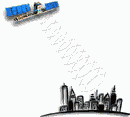
| Table of Contents |
| 1. Introduction 2. Sensors |
3. Microwaves |
| 4. Image Analysis 5. Applications |
Fundamentals of Remote Sensing
3.11 Endnotes
You have just completed Chapter 3 - Microwave Sensing. You can continue to Chapter 4 - Image Interpretation and Analysis or first browse the CCRS Web site for other articles related to microwave remote sensing.
You can get more information about remote sensing radars by checking out an the overview or the more detailed technical specifications of Canada's own microwave satellite: RADARSAT. You can even see photos of the satellite being built, watch a video of the launch and see the very first image! As well, learn how microwave remote sensing is used for various applications such as agriculture, forestry, and geology, and see international applications of RADARSAT imagery.
Learn about a new way of reducing speckle in a radar image that was developed by scientists at CCRS in co-operation with scientists in France. As well, learn how a digital elevation model can be used to correct topographic distortions in radar images or how a radar image is calibrated using precision transponders and see the mysterious movement of the transponder when shown in an image!
A training manual has been prepared on how radar data can be used to obtain stereo images. Interferometry is another fascinating technique studied extensively at CCRS. It has been tried with both airborne and satellite data and applied to detecting changes in the land, glacier movement and ocean studies.
Our Remote Sensing Glossary has extensive terminology and explanations of microwave-related concepts which can be accessed through individual term searches or by selecting the ![]() "radar" category.
"radar" category.
| Updated 2002-11-27 | Important Notices |